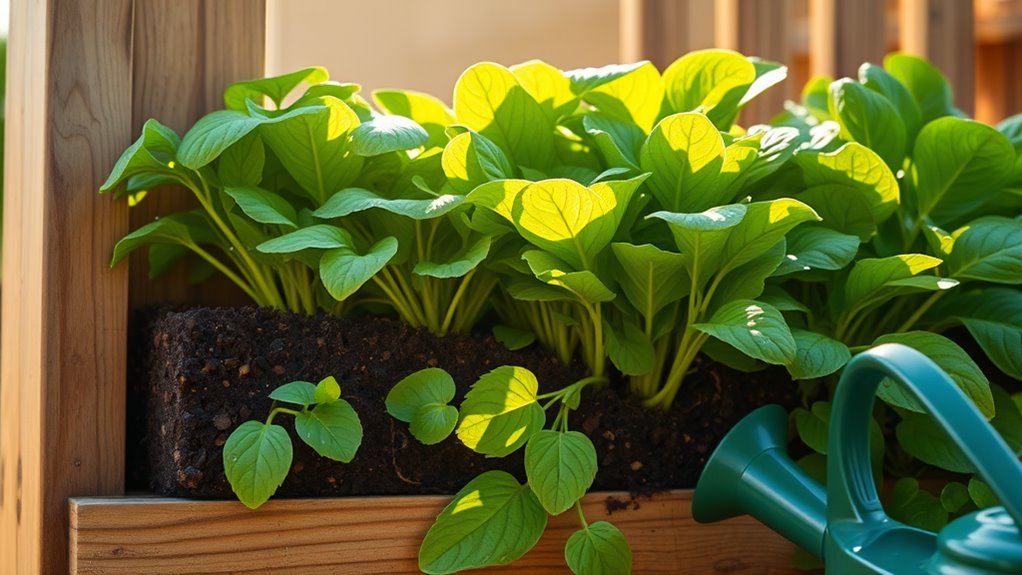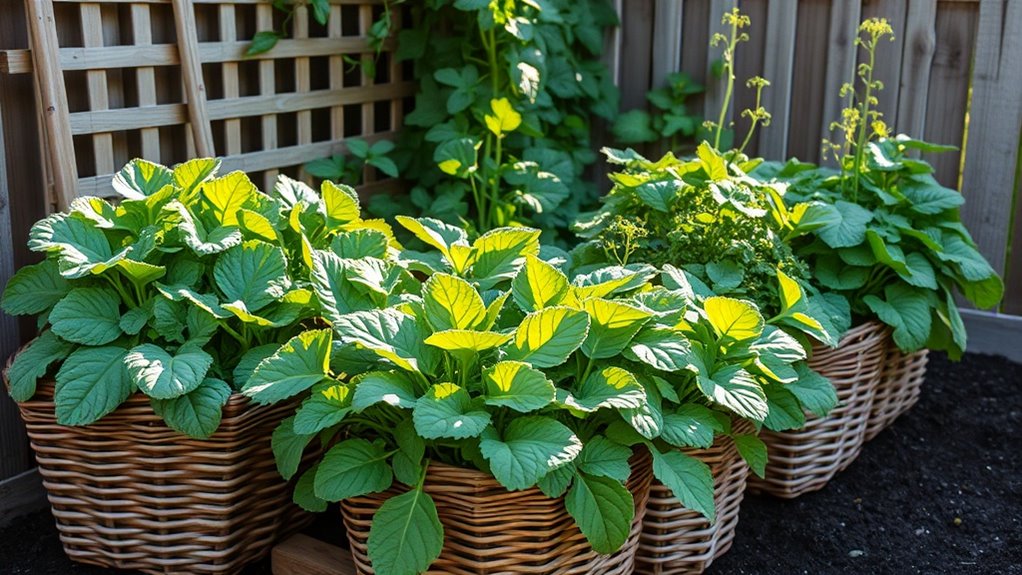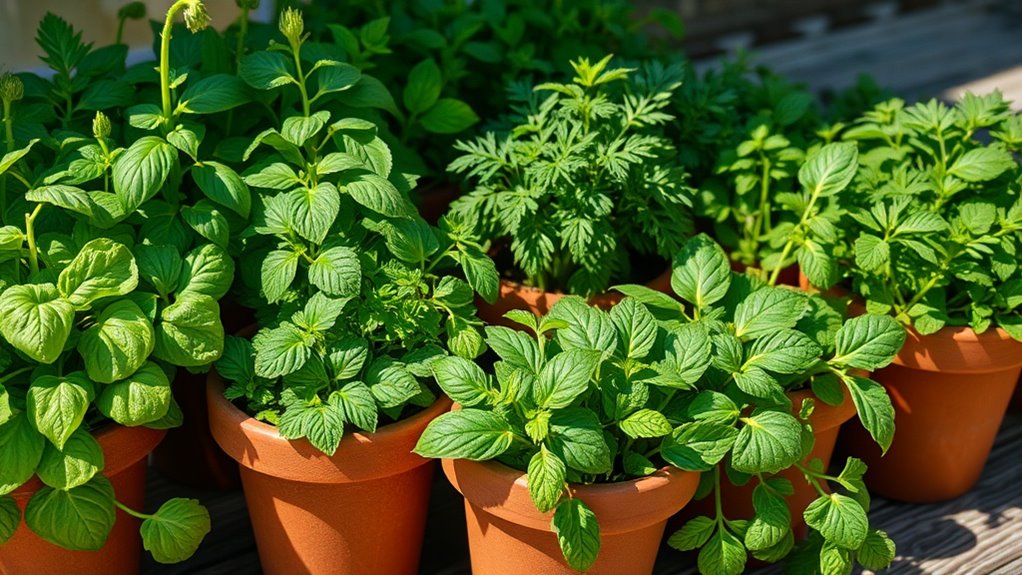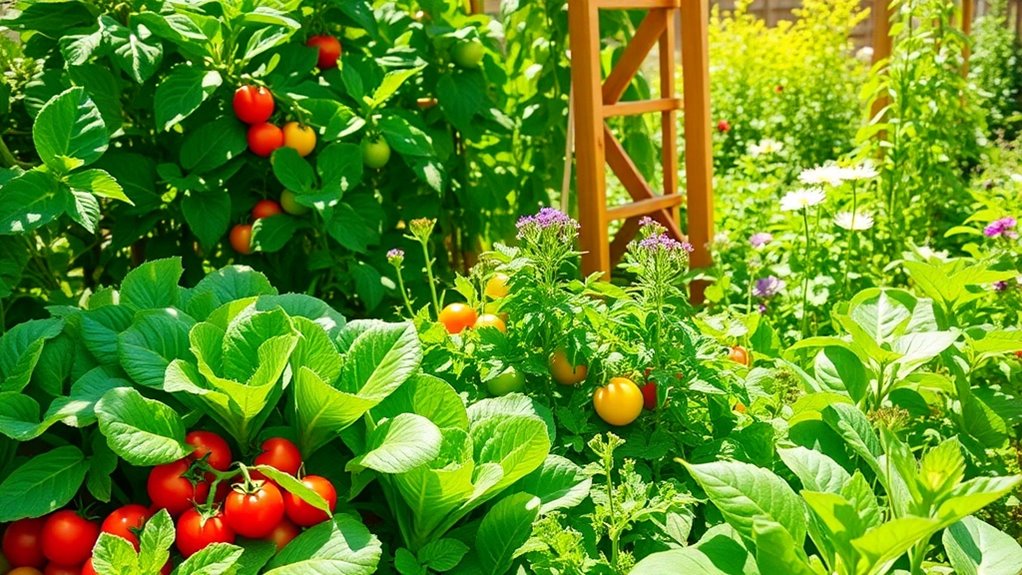How to Grow Carrots and Spinach Without Digging a Garden
If you want to grow carrots and spinach without the hassle of digging a traditional garden, it’s essential to start with the right containers and soil. Choosing deep containers for carrots and shallower ones for spinach is key. You’ll also need to consider the correct planting depth and spacing for each crop. Understanding the specific requirements for watering, sunlight, and temperature will set you up for success. Next, let’s explore how to prepare your containers effectively.
Key Takeaways
- Use deep containers (12 inches for carrots, 6-8 inches for spinach) with drainage holes to grow without traditional digging.
- Select a loamy soil mix with organic matter for optimal moisture retention and nutrient support in your containers.
- Opt for seeds for a cost-effective way to grow a variety of carrots and spinach, allowing for seed saving.
- Plant carrot seeds ¼ to ½ inch deep and spinach seeds ½ to 1 inch deep, spacing them appropriately for healthy growth.
- Maintain consistent moisture, provide balanced organic fertilizer, and ensure at least 6 hours of sunlight daily for best results.
Choosing the Right Containers
When it comes to growing carrots and spinach without digging, selecting the right containers is crucial for success. You’ll want to choose deep containers for root greens like carrots, ensuring they’ve at least 12 inches of depth. Opt for wide containers to accommodate the spreading roots.
For leafy greens like spinach, a shallower container of about 6-8 inches will suffice.
Make sure your containers have drainage holes to prevent waterlogging, which can harm both root and leafy greens.
Using materials like plastic or wood can help retain moisture while providing proper support for your plants to thrive. Additionally, container depth is vital for the healthy growth of root vegetables, as it allows for adequate root development.
Selecting the Best Soil Mix
Choosing the right containers sets the foundation, but selecting the best soil mix is just as important for growing carrots and spinach successfully.
A quality soil mix ensures proper drainage, aeration, and nutrient availability.
Here’s what to look for:
- Loamy Texture: Aim for a blend of sand, silt, and clay for optimal drainage and moisture retention.
- pH Level: Ensure a pH between 6.0 and 7.0 for ideal nutrient uptake.
- Organic Matter: Incorporate compost or well-rotted manure to enrich nutrients.
- Lightweight Additives: Consider perlite or vermiculite to enhance aeration and prevent compaction.
Additionally, including essential soil ingredients like minerals and nutrients will further support plant health and growth.
Seeds vs. Seedlings: What to Choose
When deciding between seeds and seedlings, you’ve got to weigh the pros and cons of each option.
Seeds offer a wider variety and often come at a lower cost, while seedlings can save you time and provide a head start in the growing process. Additionally, starting from seeds in containers can allow for more flexible growing options, especially in limited spaces.
Understanding these benefits will help you make an informed choice that suits your gardening goals.
Benefits of Seeds
Seeds offer gardeners a unique opportunity to cultivate their plants from the ground up, literally.
Choosing seeds over seedlings has several advantages:
- Cost-Effective: Seeds are generally cheaper than seedlings, allowing you to grow more plants for less money.
- Variety: You’ll find a wider selection of varieties, including heirloom and specialty options, that aren’t always available as seedlings.
- Control: Starting from seeds gives you control over growing conditions, ensuring optimal health and vigor.
- Sustainability: Growing from seeds encourages self-sufficiency, as you can save seeds for future planting, reducing waste and cost.
Advantages of Seedlings
Many gardeners find that opting for seedlings can significantly streamline the planting process and enhance the success rate of their crops. Seedlings give you a head start, as they’re already germinated and established, reducing the waiting time for your harvest.
They’re often more resilient to pests and diseases, providing a stronger foundation for your plants.
Additionally, seedlings allow for better control over growth conditions, ensuring you can choose healthy plants suited to your garden’s climate. By selecting robust seedlings, you’ll minimize the risks associated with seed germination and increase the likelihood of a bountiful carrot and spinach yield.
Ideal Planting Depth and Spacing
When planting carrots and spinach, understanding the ideal seed depth and spacing is crucial for healthy growth.
Carrots typically require a planting depth of about half an inch, while spinach seeds should be sown about one inch deep.
Additionally, maintaining optimal spacing between plants can enhance air circulation and reduce competition, maximizing your harvest. To achieve the best results, consider using container gardening techniques that can help you create a thriving salad garden right on your balcony.
Seed Depth Requirements
For optimal growth, carrots should be planted about ¼ to ½ inch deep, while spinach seeds thrive best at a depth of ½ to 1 inch.
Proper seed depth is crucial for germination and healthy growth.
Follow these guidelines:
- Carrots: Ensure a depth of ¼ to ½ inch for good results.
- Spinach: Aim for a depth of ½ to 1 inch to promote robust development.
- Moisture: Keep the soil consistently moist until seeds germinate.
- Soil Type: Use loose, well-draining soil to facilitate root growth.
Stick to these depths for a successful harvest!
Optimal Plant Spacing
Achieving optimal plant spacing is essential for ensuring that both carrots and spinach flourish in your garden.
For carrots, aim for a spacing of about 2 to 4 inches apart, allowing enough room for their roots to develop.
Spinach should be spaced about 4 to 6 inches apart to prevent overcrowding, which can lead to poor air circulation and disease.
When planting, ensure that the seeds are sown at the recommended depth—about 1/4 inch for carrots and 1/2 inch for spinach.
This spacing strategy maximizes sunlight exposure and nutrient absorption, leading to healthier, more productive plants.
Companion Planting Benefits
Companion planting can significantly enhance your gardening success, especially when growing carrots and spinach together.
These two crops thrive alongside each other, benefiting from mutual support and pest control.
Here are four key benefits to consider:
- Nutrient Sharing: Spinach’s shallow roots complement carrots’ deeper roots, optimizing soil nutrient use.
- Pest Deterrence: Spinach can help distract pests away from carrots, reducing damage.
- Microclimate Creation: Spinach provides shade, which can protect young carrot seedlings from harsh sunlight.
- Efficient Space Use: Interplanting maximizes your garden space, allowing for a diverse harvest.
Utilize these benefits for a thriving garden!
Watering and Nutrient Requirements
Understanding the watering and nutrient requirements for growing carrots and spinach without digging is essential for a successful harvest.
Water your plants consistently, ensuring the soil remains moist but not waterlogged.
Aim for about an inch of water weekly, adjusting for rainfall.
For nutrients, use a balanced organic fertilizer, applying it every four to six weeks.
Carrots prefer potassium-rich fertilizers, while spinach thrives on nitrogen.
Incorporate compost into the soil to enhance nutrient availability.
Monitor your plants closely, as signs of yellowing or stunted growth may indicate nutrient deficiencies.
Regularly check moisture levels to promote healthy, robust growth. Additionally, plants benefit from an ideal watering schedule, which can help prevent over or under-watering.
Sunlight and Temperature Considerations
How can you ensure your carrots and spinach thrive without digging?
Pay attention to sunlight and temperature.
Here are some key considerations:
- Sunlight: Aim for at least 6 hours of direct sunlight daily to boost growth.
- Temperature: Carrots prefer cooler temps (60-70°F), while spinach thrives in 50-60°F.
- Shade: Use shade cloth during peak summer heat to prevent bolting in spinach.
- Timing: Plant carrots in early spring and spinach in late summer or early fall for optimal results. Additionally, consider planting crops ideal for spring to maximize your harvest throughout the growing season.
Pest Management and Maintenance Tips
While ensuring your carrots and spinach receive the right sunlight and temperature is vital for their growth, managing pests is equally important for a bountiful harvest.
Start by regularly inspecting your plants for any signs of pests such as aphids or caterpillars. Use organic insecticidal soap or neem oil to treat infestations. Companion planting can also help; consider growing marigolds alongside your crops to deter harmful insects. Additionally, using natural sprays can effectively repel aphids and other garden pests.
Maintain proper watering and avoid overcrowding to reduce stress on your plants.
Lastly, keep your garden tidy by removing debris, as it can harbor pests and diseases. Regular maintenance is key to a healthy harvest.





